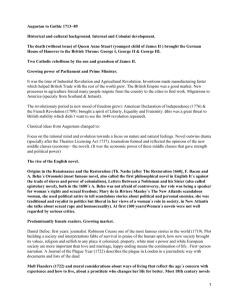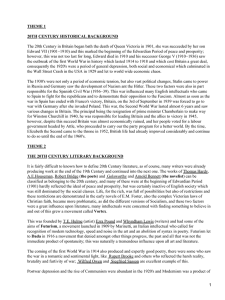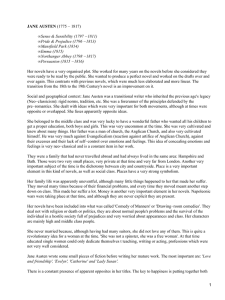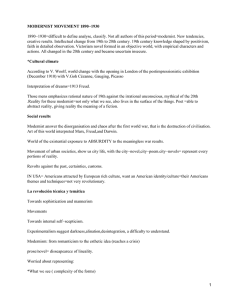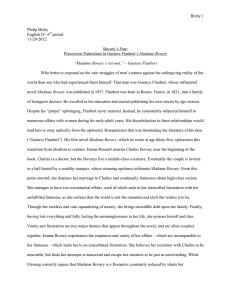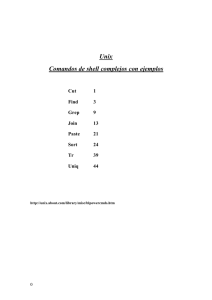British novels from the 18th and 19th centuries
Anuncio
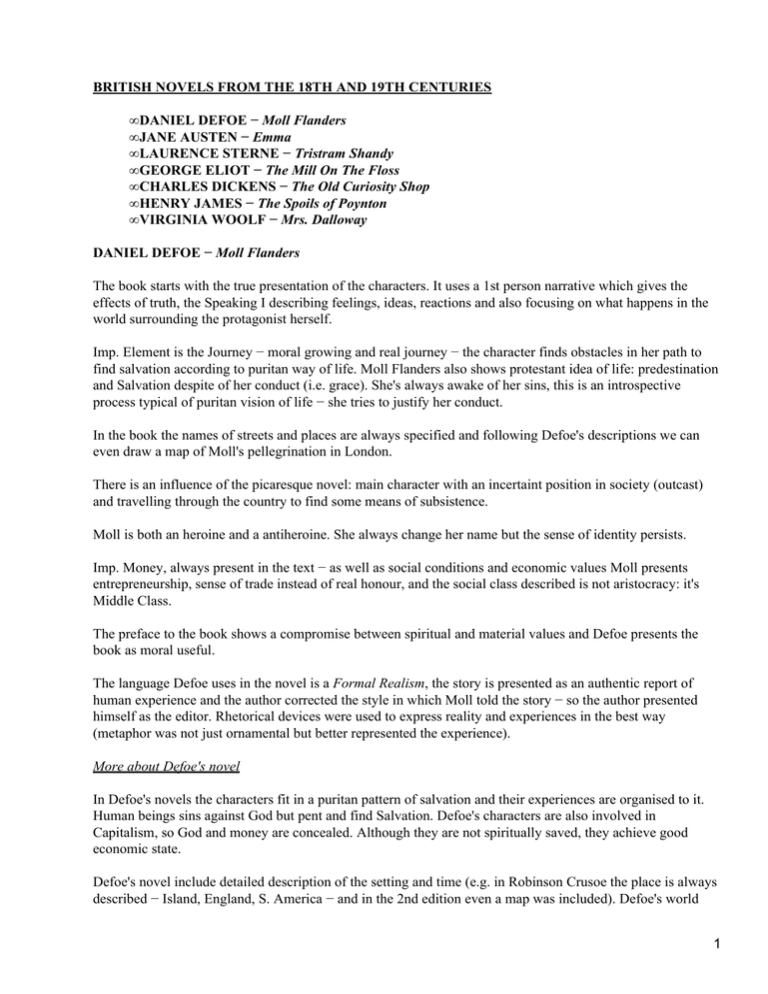
BRITISH NOVELS FROM THE 18TH AND 19TH CENTURIES • DANIEL DEFOE − Moll Flanders • JANE AUSTEN − Emma • LAURENCE STERNE − Tristram Shandy • GEORGE ELIOT − The Mill On The Floss • CHARLES DICKENS − The Old Curiosity Shop • HENRY JAMES − The Spoils of Poynton • VIRGINIA WOOLF − Mrs. Dalloway DANIEL DEFOE − Moll Flanders The book starts with the true presentation of the characters. It uses a 1st person narrative which gives the effects of truth, the Speaking I describing feelings, ideas, reactions and also focusing on what happens in the world surrounding the protagonist herself. Imp. Element is the Journey − moral growing and real journey − the character finds obstacles in her path to find salvation according to puritan way of life. Moll Flanders also shows protestant idea of life: predestination and Salvation despite of her conduct (i.e. grace). She's always awake of her sins, this is an introspective process typical of puritan vision of life − she tries to justify her conduct. In the book the names of streets and places are always specified and following Defoe's descriptions we can even draw a map of Moll's pellegrination in London. There is an influence of the picaresque novel: main character with an incertaint position in society (outcast) and travelling through the country to find some means of subsistence. Moll is both an heroine and a antiheroine. She always change her name but the sense of identity persists. Imp. Money, always present in the text − as well as social conditions and economic values Moll presents entrepreneurship, sense of trade instead of real honour, and the social class described is not aristocracy: it's Middle Class. The preface to the book shows a compromise between spiritual and material values and Defoe presents the book as moral useful. The language Defoe uses in the novel is a Formal Realism, the story is presented as an authentic report of human experience and the author corrected the style in which Moll told the story − so the author presented himself as the editor. Rhetorical devices were used to express reality and experiences in the best way (metaphor was not just ornamental but better represented the experience). More about Defoe's novel In Defoe's novels the characters fit in a puritan pattern of salvation and their experiences are organised to it. Human beings sins against God but pent and find Salvation. Defoe's characters are also involved in Capitalism, so God and money are concealed. Although they are not spiritually saved, they achieve good economic state. Defoe's novel include detailed description of the setting and time (e.g. in Robinson Crusoe the place is always described − Island, England, S. America − and in the 2nd edition even a map was included). Defoe's world 1 can be defined as an itemised world: all the objet people use and have are always described, there is a mass of circumstantial details. Society described by Defoe is a society that is rapidly changing since Capitalism ethics is radically replacing the religion−based ethic of feudalism. JANE AUSTEN − Emma In Emma dilettantism is shown as fun, as Jane Austen criticises the provincial amateurish attitude to art − Emma is a dilettante painter. For Jane Austen art is not only natural genius but also constant work. Nature in Emma is far from being wild (in fact this element in J. Austen's novels is opposite to Romanticism where for example lovers met in wild natural settings), here the natural settings are culturalised (e.g. gardens) − strawberry party at Dounwell Abbey and Picnic at Boxhill (which also represent forms of social entertainment − so nature is seen as a social occasion too). Emma is the perfect heroine (handsome, clever and rich − this description can be considered ironical as seemed to unite the best blessings of existence) who has everything from the beginning, this is opposite to the typical traditional novel where we find the so−called Cinderella−plot (woman climbing society showing moral integrity). On the other hand Mr. Knightley is the perfect gentleman who doesn't need any kind of improvement and while in traditional sentimental novels it's the man who has to demonstrate his love to the heroine in Emma the heroine undergoes moral growth to deserve the love of the male character. The plot shows Emma's mistakes: she thinks she's omniscient (she thinks she knows everything about everyone and she can read into everybody's heart) and she will find out she's mistaken only at the end of the book. Emma in fact can only sees people's external behaviour, obsessions, manias: people's hobby−horses. Emma wants to behave like an omniscient author who has a God−like attitude toward her characters (omniscience is a basic element of literature as the author can describe everything − while in real life we only have external visions). Emma wants to behave like a stage director who tells the actors what they have to do; she's a sort of antagonist of the author himself and in fact she's defined as the plotter, because she wants to make a plot according to her wishes: she has a metafictional function within the novel (matafiction is fiction about fiction: referred to all the devices used by an author to draw the reader's attention to the problems of the work itself). Emma wants to arrange marriages among other characters but she says she will never marry, so she keeps out of the game. The book starts and ends with a marriage (and the fist marriage was in fact arranged by her). Emma behave as if she were an artist and the world represents something she wants to model as if she were a superior God−like artist. In the novel there are some mythological references: e.g. Pigmalion − as Emma is compared to him as she wants to transform Harriet into a work of art (and Harriet is the ideal subject for her treatment as she's a sort of Miss Nobody from Nowhere − she doesn't even know who their parents are − and a sort of blank − pretty but modest − and submits to Emma's will without opposing any resistance). Emma idealises Harriet, even in her portrait (painting her taller), she also wants to expose the portrait (as if Harriet were an object of her own). Emma has a dangerous influence on Harriet. Emma is not able to distinguish between art and life, objects and people, only Mr. Knightley realises her wrong attitude towards other people. Emma anticipates a technique used later by Henry James which gives dramatic importance to psychological 2 events: there is a psychological moment when Emma is meditating alone. In the book everything is described from the point of view of the characters and we don't perceive the presence of the narrator: everything is filtered by characters' consciousness. There isn't a narrator but we perceive a double point of view in the use of language and ironic style, only in this point we can perceive the implied author. More about Jane Austen's novels Jane Austen's existence is mirrored in her novels which are set in small town and portrait a provincial and rural society of Middle Class people absorbed in everyday life; there are no great events, just conversations, parties, balls and marriages. The suspense is determines by the question Who shall marry who?. Great historical events are never reported. Jane Austen's Novels wanted to deal with private life and events (we can talk about Private History) and public history represents the background. Jane Austen can be considered as the perfect novelist as she uses all the main characteristics of the novel as a literary genre (which in fact emerged in this period). She pointed out the difficulty of being a good novelist and for example in Northanger Abbey she complains about the fact that some people consider the novel as a secondary form of literature. She defended the novel. Her novels are a reaction against Gothic novels and she even made a parody of one of them in Northanger Abbey, in which all the elements of Gothic undergo a deflation (they're brought back to reality and to trivial everyday things and events. This element of reality of Jane Austen is also opposite to the sublime, as she wants to describe life in a realistic way. Jane Austen also adopted a classical attitude against the romantic attitude (Romanticism had already appeared in her times), so we can consider her a classical author as she praise decorum and appropriateness both in her approach to art and in her descriptions of social life. She had a highly professional idea of the role of an artist, she thought being an artist meant working hard. Jane Austen is a Janus−faced novelist as she makes use of traditions as well as of forms from the 19th and 20th Centuries (Janus is a mythological character with a face to the past and a face to the future). Psychological insights are basic in her novels as the main events usually coincide with the heroine's decisions: the heroine herself changes her mind acquiring a new awareness (psychological growth). LAURENCE STERNE − Tristram Shandy The plot is fragmentary, full of digressions , completely unpredictable. It seems to have a casual plot and the narrator pretends not to control it, but in fact it's not true. The book reflect the total unpredictability of human nature and life. The novel can be considered as a sort of conversation between the imagination of the author and the imagination of the reader. The reader must participate in the creation of the book. There is also another important innovation: Sterne considers the book as a tangible object made of words. Letters and graphic marks. We find a blank page after a death and even a marble page. The novel is apparently an autobiography (first person narrative) in which Tristram tries to tell his own life, with the complete task of turning into writing both actions and thoughts (in fact the complete title of the book is The Life and Opinions of T. S. Gentleman). 3 The book presents the concept of hobby horses (i.e. personal obsessions). Each character has his hobby horse: the study of philosophy and rhetoric for Walter, the obsession for military fortification for Uncle Tobey, the intention of writing his biography for Tristram, etc. In the novel all the events are united like rings and all the experience is a net of facts relate one to another and it is impossible to realise when one stops and another starts. The world in the novel is dirty and mysterious. It is infinitely variable showing a dimension governed by changing and mutability of elements (in fact the book is dedicated to the moon, the planet of mutability) Humour derives from the description of little things happening in everyday life. The novel includes different kind of speech and languages (e.g. legal, theological, scientific). More about Sterne's novels Sterne followed Locke's concept about association of ideas which included a passive process of perceiving surrounding things and an active process of reproducing them with the help of imagination. This reminds us to the theory of Stream of Consciousness which James Joyce will diffuse following Freud's concepts. In fact Sterne is often compared with Joyce as it was an experimental novelist too. The two main faculties Sterne considered were Wit and Judgement, and he thought they both had the same importance. By wit Sterne intended the faculty of connecting distant things and imagination. Sterne considered writing only a convention, nothing to do with real life. He adopted the theory of hobby horses because he thought it was impossible to read inside other people's hearts. GEORGE ELIOT − The Mill On The Floss In The Mill On The Floss the narrator speaks in first person and starts the novel with the description of nature, full of personal recollections. Such a description forms the narrative frame with which the story will be told. The book shows some realistic elements: the parents speak in a sort of dialect; the old theme of contrast between countryside and city is also present (e.g. when Mrs Tulliver expresses her disgust for people who live in town when she says they wear false shirt−fronts. In Chapter 3 there is a dramatic presentation of a character which introduces a contrast between old fashioned and new people. This novel is feminist as daughter Maggie is more intelligent than her brother and her mother says it is not positive for a girl to be clever. She always reads and she is presented as a generous character but with a streak of evil. She's the real protagonist of the novel and she fascinates the reader, she's not rational but she understand what is going to happen, while the reader knows Tom is a good boy but he won't be successful in life. Maggie is absolved in reading (and playing music) and she is disappointed by reality, this will increse as she finds bad experiences in her life, in a way she leaves to fantasy. The narrator in the novel is a sort of moralist who remarks specific situations (this is a new element in novel as in previous novels there was only general interference − a typical Victorian element G. Eliot represented was the Writer's responsibility − especially moral responsibility). In the novel there is a strong presence of water, the river is sometimes a dangerous element, sometimes a peaceful one. The novel shown how our life is rooted in childhood and even later if we act with our own rules we can't forget our childhood (this is a typical Victorian thinking). 4 The story of Maggie and Tom is the contrast between Tullivan family and the changing society (this is represented in the novel by the comparison between the spiders living in the Mill and the ones outside. From the beginning of the novel we know something bad will happen: Mr Tulliver is into dangerous trades (borrowed money). The story includes funeral, deaths and disasters. It also gives a real image of Victorian Society, where honour is no longer as important as it was. The style is intelligent and there is a new kind of sight in the family (i.e. domestic life including discussions and different points of view between husband and wife. Money is what governs the novel and the rural element is idealised. The novel present a regression end, not a marriage or something similar, but a death, as a sort of return to childhood (represented by the river), a regression to memory − Tom and Maggie together forever in the grave = a sort of going back to the Garden of Eden, where brother and sister find serenity. More about G. Eliot's novels George Eliot presented a disconnection between contemporary values and absolute values, i.e. old values persist in a world that has changed. Some different social classes are considered and there is an evident contrast among them (while for example in J. Austen's novels there was only one social classes − the gentry −is considered). Eliot presented a very big interest in moral life as all the great novelists. CHARLES DICKENS − The Old Curiosity Shop This novel ca be considered as a sort of modified Picaresque novel. Little Nell moves to England (represented as a sort of Garden of Heaven − with a sort of fairy tale landscape) with a dwarf (representing the devil): in all the novel we can find this contrast between good (Nell) and evil (the dwarf), which can be considered as a typical Romantic element. In the novel the isolation of individuals is shown and London appears as a place of helpless, anonymity: a field of poverty and a sort of labyrinth (symbol of evil produced by industrialism) where the inhabitants have a deformed life and experience suffering. Nell and her grandfather leave to the countryside: this shows love for countryside and hatred for city (very typical element in Victorian Age for Aristocracy: houses out of town or gardens in the city). The novel includes a lot of contrast: light vs. darkness, youth vs. old age, good vs. evil. Nell is a sort of spirit of the book surrounded by evil and grotesque nature of human society, she is in contrast to evil and darkness and deformity prevails in the novel. A basic element of the text is the grotesque: Mr. Quilp represents this element as he's deformed (including lack of proportion − big shoes, big head − he's like a sort of monster); he also represents the evil which can't be stopped. On the opposite Kit Nubbles contrasts Mr. Quilp as she is the personification of goodness. In the novel there are some anonymous characters without name (this is a typical element of fairy tales): the grandfather, the gentleman, the school masters and also some places have no name (e.g. the journey in Central 5 England doesn't include any itinerary). The title itself is not relevant in the novel as the curiosity shop is not important in the story. The novel was published in serial in Mr. Humprey's clock in 1840 − a collection of articles and stories from the members of a club. More about Charles Dickens' novels C. Dickens is the first great novelist of the Victorian Age, characterised by a society which is rapidly changing (because of the industrial revolution) Dickens' novels are inspired by his personal experiences which included economic instability, school interruption, his father in prison, frequent changing of house, working in a factory when he was 12. He began his career as a newspaper reporter and wrote articles describing London habits. He wrote fourteen novels characterised by elaborated plots and a particular sense of humour. In his novels he showed a big awareness of social problems of his time, such as poverty of the masses, selfishness of rich upper classes, plight of the working classes, spiritual and material corruption. Some other main elements of his novels are education, charity, religion, social morality, society and forms of government. He wrote adventure novels (e.g. Oliver Twist in 1837) as well as autobiographical novels (e.g. David Copperfield in 1843 and Great expectations − considered his masterpiece − in 1860). He presented a satirical view of reality: he was essentially a comic writer who used irony to create caricatures against cruelty and injustice in society. His narrative style moves from comedy to tragedy. His novels were published in magazines and newspapers, usually in monthly parts: being aware of the public reactions he could change the story according to public interest, and he tried to put suspense in every part , even introducing new characters (as if they were actors). HENRY JAMES − The Spoils of Poynton The novel presents a contrast between people who have taste and aesthetic awareness and those who have neither one nor another. One of the main characters of the book is Mrs. Gareth who has an incredible sense of beauty, so exasperated (she couldn't sleep because of the ugliness of the wallpaper of her room!). The novel is set in a small English town and starts describing Mrs. Gareth (a middle−aged widow who is going to the Church and is reflecting about the lack of taste surrounding her (she even suffer physically because of it). Then she meets a woman she really admires, Fleda, who is poor and not beautiful but has a profound sense of beauty, a taste distinguishing her from other people in the village. An important communion takes place between the two woman whose meeting are a sort of recognition as they don't even need to talk, it is enough to look into each other's eyes. But the two women present an important difference: Mrs. Gareth sees beauty as something inseparable from material element of object, she can't stand ugliness and vulgarity and she could never live in a house that does not satisfy her taste (so taste for her has a vital need) while Fleda has such a deep sensibility that she can renounce to material beauty, it is enough for her to preserve beauty as a vision of perfection. Fleda cannot accept a compromise to possess beautiful things (e.g. commit an action blameable from a moral point of view). In the preface to the book Henry James says Fleda is the only one person who can feels and sees (she has a visionary power). Another important difference between the two women is the fact that Mrs. Gareth's passion for things has 6 repressed her humanity while Fleda is human in the higher degree and represents the higher sensibility. Mrs. Gareth's son Owen can't understands beauty, she doesn't want him to marry Mona, a beauty girl completely meaningless, without expression and consciousness who represents in the novel the lowest level of humanity, she's obstinate (refuses to move, to talk). Mrs. Gareth wants Owen to marry Fleda as his son will expropriate Poynton (the parental house) if he marries Mona, since Mrs. Gareth is a widow. Poynton represents a sort of work of art as Mr. Gareth transformed it into perfection, that's why Mrs. Gareth doesn't want to leave the house although she owns another one. Pynton is the real centre of the novel, it is presented as an organism (not an object), a living being, and Fleda represents the voice of all the unarticulated objects of the house (she is the mouth−piece). In fact in the text there is no omniscient author and we have the impression that characters' minds weave the texts, and this is all constructed through Fleda's thoughts. Imp.: Beauty is considered as a sound (harmony) and lack of beauty is a sound out of tune. Perfect beauty is soundless (representing real devotion to beauty) while lack of beauty is loud. More about Henry James' novels Henry James lived most of his time in the Victorian period nut he can't be considered a Victorian novelist as he differentiated form them and even criticised them (e.g. he considered Dickens' novel had unreal characters and G. Eliot's ones included too many details and too much analysis). In fact H. James belong to Late Victorianism, which is the period of transition between Victorianism and Modernism (historically it's a period of decadence following the loss of faith in the main believes of the Victorian Age (progress, science, positivism, industrialism). This period (which is also called The Turn Of The Century − it's the end of the 19th Century) there is the advent of Aestheticism which was based on intensification of perceptions: beauty is thus emphasised (following the principle of Art for art's sake) Henry James is the author who better represent this passage to Modernism as he introduced the most innovative and self−conscious experiences. He thought morality has nothing to do with the content of the novel and there is no distinction between the characters and the plot as the characters themselves make the plot. All the novel includes a centre of consciousness which creates the fictional world and the action of the novel itself. In his novels there is no omniscient author (typical in Victorian novels) as we see reality only through the characters' eyes. H. James considered a novel an organism (all is mixed together), not a mechanism. H. James was from New York but spent most of his life in Europe, the continent he loved. He thought in Europeans had more aesthetic awareness and in his novels Americans change when they come to Europe. VIRGINIA WOOLF − Mrs. Dalloway The main theme of the novel is personality affecting and affected by others who come into contact with the main character. Time moves from the preparation of her party in the morning to the moment preceding the party itself in the evening. She evokes memories and her story is unfolded. In the novel there is also another story: the story of Septimus. 7 There are five major characters who move around each others in two concentric circles: • Clarissa, Peter Walsh (the man she wash in love with) and Richard (her husband) = one circle • Septimus and his wife = another circle Around these inner circles there are minor characters and in the background there is also a group of unimportant figures helping to create the complete story (that can be considered as a sort of Puzzle) In the end the story doesn't seem to be the one of Clarissa nor the Septimus' one, but Human Life. The novel presents in fact different points of view revealing human personality partly through self−consciousness and partly through pictures projected into other people's minds. More about Virginia Woolf's novels Virginia Woolf is a modernist novelist, and all her novel reflects the main elements of Modernism, such as the weakening of traditional narrative structure and unity and some special features as repetition, images, symbols, as well as the refusal of the straight chronological order. There isn't any reliable omniscient or intrusive narrator. Modern fiction also employs either a single limited point of view or multiple points of view and tends towards a complex handling of time with much cross reference back and forward across time of action. Other important Modernists are James Joyce, E.M. Foster and D.H. Lawrence. About James Joyce James Joyce is the most important modernist authos, mostly associated to Virginia Woolf. He followed the Stream of Consciousness technique: time is seen as a fluent continuity while consciousness is like a river. Modernism aimed to translate consciousness and for this Joyce invented an elaborated new technique of writing, without bounds and with a variety of styles (including dialogs and thoughts). In Ulysses he introduced the Poliphony technique, which included the presence of all styles in one work, while in Dubliners he used the Epiphany (also present in Stephen Hero) which is like a moment of suspension 8
